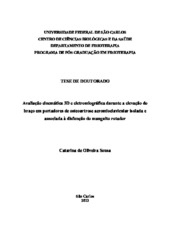Avaliação cinemática 3D e eletromiográfica durante a elevação do braço em portadores de osteoartrose acromioclavicular isolada e associada à disfunção do manguito rotador
Abstract
The acromioclavicular osteoarthritis (ACO) is a source of shoulder pain, that can occur in isolation or be associated with rotator cuff dysfunction (RCD). Individuals with RCD present altered shoulder kinematics and muscle activity. However, there are not studies that have been evaluated shoulder kinematics and muscle activity in ACO conditions. Thus, the prime purpose of this Doctorate project was to evaluate the three-dimensional shoulder motion and muscle activity during the arm elevation in individuals with isolated ACO and ACO associated with rotator cuff disease (ACO+RCD), as compared to controls. The study was divided in two parts: Part 1 - Three-dimensional shoulder kinematics; and Part 2 - Muscle activity. 74 individuals took part in this study (23 isolated ACO, 25 ACO+RCD, and 26 controls). Pain and function were assessed with Disabilities of the Arm, Shoulder and Hand (DASH) questionnaire, threedimensional shoulder kinematics of scapulothoracic, sternoclavicular, and acromioclavicular joints was evaluated with surface electromagnetic sensors, and surface electromyography of upper trapezius (UT), lower trapezius (LT), serratus anterior (SA), and anterior deltoid (AD) data was collected with Bagnoli-8 (DelSys®) system and synchronized via Motion Monitor software. The individuals were evaluated during arm elevation (ascending and descending phases) in sagittal and scapular planes, and pain during motion was assessed with 0-10 scale. Group comparisons were made for the DASH and pain with Kruskay-Wallis tests, and for each muscle during the maximum voluntary isometric contraction (MVIC) with one-way ANOVA. For each kinematic variable and muscle during the motion, separate linear mixed-model 2-way ANOVAs were performed. Both groups with ACO had higher DASH and pain scores. For the scapulothoracic motion, isolated ACO group had increased internal rotation than control, and the ACO+RCD group presented increased upward rotation than others. For sternoclavicular joint, both groups with ACO presented less retraction in the sagittal plane, and the isolated ACO group presented less elevation in scapular plane, and posterior rotation in both planes. For acromioclavicular joint, the isolated ACO group presented increased upward rotation, and both groups with ACO presented increased posterior tilting in sagittal plane. There was not difference between groups for MVIC. ACO+RCD group had more UT activity than the isolated ACO and control, more AD activity than the ACO during ascending phase, and more AD activity than the ACO and controls during descending phase in both planes. Isolated ACO group had less SA activity than control only during ascending phase in sagittal plane. Patients with ACO had altered shoulder kinematics and muscle activity, which may represent compensatory responses as an attempt to reduce pain.
